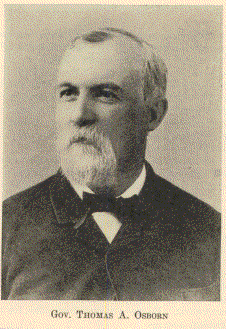| 1918 KANSAS AND KANSANS | Chapter 51 | Part 1 |
CHAPTER LI
THOMAS A. OSBORN

Gov. THOMAS A. OSBORN
[Copy by Willard of Portrait in Library of Kansas State Historical Society]
Thomas A. Osborn, the sixth governor of Kansas, was born at Meadville, Pennsylvania, October 26, 1836. There he attended the public schools, and also began his printer's apprenticeship. By his work at the printer's case he paid his way through Alleghany College.
In 1856 he commenced the study of law in the office of Judge Derrickson, of Meadville. He was admitted to the bar in Michigan in 1857. In November of the same year he came to Kansas. He stopped at Lawrence, and obtained employment as a compositor on the Herald of Freedom. By industry and ability he soon became foreman, and the paper was often left completely in his hands.
Before he was twenty-two years old Thomas A. Osborn was practicing law at Elwood, Doniphan County. He was recognized as a good lawyer and a man of integrity and ability. He was a firm Republican and Free-State man.
In 1859 he was elected Senator from Doniphan County, and took his seat in 1861. The following term he was chosen President of the Senate. He filled this position during the absence of the Lieutenant-Governor, and during the impeachment trial of Governor Robinson.
Mr. Osborn was elected Lieutenant-Governor of Kansas in 1862, defeating John J. Ingalls. At the expiration of his term of office he was appointed United States Marshal of Kansas by President Abraham Lincoln. He held this position until 1867, during which time he made his home in Leavenworth. He was removed from office for opposing the policy of President Johnson.
The wedding of Mr. Osborn to Miss Julia Delehay, of Leavenworth, took place in 1870. Miss Delehay was a beautiful and talented woman, a blood-relation of Abraham Lincoln. They had one son, Edward, born in 1871.
In 1872 Mr. Osborn was nominated as the Republican candidate for Governor of Kansas. He was elected, and began his term in 1873. The year of 1874 was the dreadful "Grasshopper Year" of Kansas - the year when these pests destroyed all crops and caused famine and untold suffering. Governor Osborn called a special session of the Legislature, which decided the emergency must be met by the issue of county bonds. Relief committees were organized, and relief sent to the sufferers. Also, during this year, the Indians began stealing from the settlers of Barber County, and the southern border generally. United States Cavalry, sent to recover the plunder, unfortunately killed a son of Little Robe, a Cheyenne Chief. This precipitated murder and raids.
Governor Osborn was in a position requiring great diplomacy. Some citizens demanded immediate vengeance, and some urged unlimited forbearance. However, he steered a successful middle course, subduing the savages, keeping the militia on the border, and yet not offending the more timid citizens by reckless fighting.
Governor Osborn was a far-sighted and prudent man, and urged on the Legislature the necessity of economy. His administration was noted for careful handling of the State funds.
Also, at this time, much was done toward colonizing and settling more land. Every encouragement was given the settler. A huge band of Mennonites from Southern Russia settled in the Arkansas Valley in 1874. Owing to the increase of population a number of new counties were organized.
In 1876 came the Centennial Exposition at Philadelphia. Thirty thousand dollars was spent for a beautiful Kansas exhibit. This brought Kansas much before the public eye. Her merits were more than ever discussed and investigated, and many new citizens were added to her people as a consequence.
On January 29, 1873, the two houses of the Legislature met in a joint session, to ballot for a United States Senator to succeed Pomeroy, whose term had expired. Before the vote was taken State Senator Alexander M. York rose and accused Pomeroy of bribing him to vote for him - Pomeroy. Pomeroy was defeated.
On the twenty-fourth of March, Senator Caldwell resigned and Governor Osborn appointed Robert Crozier to fill his unexpired term. Also, he appointed John Francis to succeed the State Treasurer, Josiah E. Hayes, who had been impeached and resigned.
In 1877, Governor Osborn was defeated for United States Senator by Preston B. Plumb.
He was appointed United States Minister to Chili by President Hayes in 1877. He filled this distinguished position for four years, at the end of which time he was sent by President Garfield to Brazil as United States Minister. His diplomatic career was distinguished for its scrupulous care and attention to the business and interest of the United States.
On is return to Kansas, in 1885, he made it known that he had no further desire for public office, preferring private life. But he was elected State Senator in 1889 by Shawnee County. He was active politically till the day of his death. In 1888 he was head of the Kansas Delegation at the National Republican Convention.
Governor Osborn's wife, always fragile in health, died in 1892. In 1898 he became engaged to Mrs. Marguerite Fowler Richmond, of Meadville, Pennsylvania. She was a beautiful woman, and of a noted family. But before the wedding took place Governor Osborn died. His death occurred February 4, 1889, at Meadville, a few days before the time fixed for the wedding. It was caused by a hemorrhage of the stomach. Governor Osborn's body was brought to Kansas, and placed beside that of his wife in a Topeka cemetery.
He was one of the most brilliant governors of Kansas, and his long career as an honored statesmen is a source of State pride.
| 1918 Kansas and Kansans | Previous Section | Next Section |
A Standard History of Kansas and Kansans , written and compiled by William E. Connelley, transcribed by Carolyn Ward, 1998.
